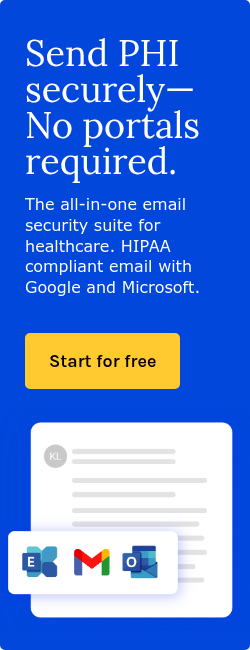6 min read
Implementation strategies for HIPAA compliant mental health screening
Gugu Ntsele May 23, 2025

Implementation strategies for HIPAA compliant mental health screening
Mental health care is a complex issue that can involve multiple specialists, additional screening, and the utmost confidentiality. Considering HIPAA is vital for ensuring patient data safety and trust. Implementing evidence-based screening and assessment strategies is a practical way to help patients while maintaining HIPAA compliance.
The growing mental health crisis
Despite the prevalence of mental health conditions, they remain largely underdiagnosed in non-psychiatric healthcare settings. According to recent research from the AAMC Research and Action Institute, "Access to care and treatment for mental health issues remains out of reach for most of the population in the United States even though more than one-fifth of U.S. adults (21%, 52.9 million) had a mental illness in 2020."
The AAMC report further highlights the growth of mental health concerns, stating, "From 2008 to 2019, the number of adults aged 18 or older with any mental illness increased from 39.8 million to 51.5 million, a nearly 30% increase. The pandemic has further exacerbated mental health problems for all ages; among adults aged 18 or older who had serious thoughts of suicide in 2020, more than one-fifth (21%) listed COVID-19 as the reason for those thoughts."
Research in primary care indicates:
- Only 50% of patients with depression are accurately diagnosed in primary care.
- Bipolar disorder is frequently misdiagnosed, leading patients to consult multiple healthcare providers before receiving an accurate diagnosis. A study published in The British Journal of General Practice reported that only 52% of individuals with bipolar disorder received a diagnosis by the first or second professional they consulted. Furthermore, 34% of sufferers experienced a diagnostic delay of more than 10 years from their first professional contact.
.Mental health professional shortages
One of the largest barriers to proper mental health screening is the shortage of qualified professionals. As the AAMC report notes, "The United States needs more mental health professionals. As of Sept. 30, 2021, an estimated 129.6 million people lived in one of the 5,930 federally designated mental health care Health Professional Shortage Areas. Less than one-third of the U.S. population (28%) lives in an area where there are enough psychiatrists and other mental health professionals available to meet the needs of the population."
The problem is particularly acute in rural settings. According to the report, "Rural areas, where 14% of the U.S. population (or 46 million people) live, have disproportionately low numbers of practicing mental health professionals compared with urban areas. Among nonmetropolitan counties, 65% had no practicing psychiatrist as compared with 27% of metropolitan counties."
Evidence-based screening tools
Patricia Robinson, founding member of Mountainview Consulting Group, stated, "Screening is useful in identifying common problems that can contribute to a decline in well-being. However, screening must be followed up with accessible treatment in order to be helpful to the individual and their family."
Robinson further notes, "There are a number of mental health screeners that are commonly used in primary care, such as the PHQ-9 for depression, the GAD 7 for anxiety, the PTSD 5, and, for children, the Pediatric Symptom Checklist – 17."
HIPAA compliant screening implementation
When implementing mental health screening, there are several HIPAA considerations:
1. Patient authorization and notification
While screening for mental health conditions generally falls under the treatment exception to HIPAA authorization requirements, best practices include:
- Incorporating mental health screening notification into your general Notice of Privacy Practices
- Using introductory language that explains the purpose of screening and how information will be used
- Ensuring patients understand their right to decline specific screening questions
- Documenting patient preferences regarding who can access their mental health screening results
As noted in Youth Mental Health Screening and Linkage to Care, "It is important to consider issues related to privacy, including individuals being unsure of confidentiality limits. Concerns can arise regarding whether responses can be shared with family members, school staff, or even law enforcement. These issues require up-front efforts to ensure privacy and a safe place to discuss symptoms, as well as discussions of confidentiality boundaries."
Robinson explains, "Mental health records include information about screening and intervention, and mental health records are considered protected health information (PHI). Mental health records are subject to the same privacy and security rules as other medical records. HIPAA protects the privacy and security of individually identifiable health information, and requires healthcare providers, health plans, and clearinghouses who handle PHI to safeguard this information."
2. Screening tool selection and documentation
Different screening tools create different HIPAA implications:
- Paper-based screening: Physical forms must be secured according to HIPAA physical safeguard requirements and either incorporated into the medical record or destroyed according to proper protocols
- EHR-integrated screening: Access controls should limit mental health screening results visibility to appropriate staff, with audit trails monitoring access
- Tablet-based screening: Ensure devices are configured for automatic logout, data encryption, and secure transmission to medical records
- Patient portal screening: Must meet HIPAA compliant portal requirements, including secure authentication and transmission encryption
The Youth Mental Health Screening and Linkage to Care research emphasizes that "all screening data will need to be housed in a secure manner, such as a HIPAA compliant cloud-based online format. Protections would also need to be in place regarding access to any information contained on the online portal."
3. Results communication and documentation
How screening results are communicated and documented implicates several HIPAA provisions:
- Positive screens should be discussed in private settings
- EHR documentation should utilize appropriate mental health templates that maintain required separation between general medical information and protected mental health information when applicable
- Communication of positive screens to other providers must follow the minimum necessary standards
- When using standardized screening tools, document the specific tool, score, and clinical interpretation rather than including full question responses
The Youth Mental Health Screening and Linkage to Care research highlights an important consideration for HIPAA compliant documentation: "For youth under the age of 18, a parent or guardian will need to provide consent. Consent in school settings will require different logistical considerations than in medical settings... The screening program will also need to be sensitive to the particular set of complex challenges in place for youth in foster care."
The insurance barrier
Even when screening tools identify mental health conditions, patients often face barriers to accessing care. The AAMC Research and Action Institute highlights the following statistic, "In 2020, among adults aged 18 or older who had any mental illness in the past year and a perceived unmet need for services, 30% reported not receiving care because their health insurance did not cover any mental health services or did not pay enough for mental health services."
Furthermore, "While the Mental Health Parity and Addiction Equity Act of 2008 mandates equal coverage and benefits for mental health and general medical conditions, gaps between insurance coverage for mental health conditions and other medical conditions still exist and are growing."
Special populations and considerations
Geriatric patients
Mental health screening for older adults should account for:
- Symptom presentation differences (more somatic complaints, less psychological distress reporting)
- Cognitive status assessment as part of mental health screening
- Medication sensitivity and polypharmacy considerations
- Modified cutoff scores on standard instruments (e.g., Geriatric Depression Scale)
According to the World Health Organisation, “Around 14% of adults aged 60 and over live with a mental disorder (2). According to the Global Health Estimates (GHE) 2019, these conditions account for 10.6% of the total disability (in disability adjusted life years, DALYs) among older adults. The most common mental health conditions for older adults are depression and anxiety. GHE 2019 shows that globally, around a quarter of deaths from suicide (27.2%) are among people aged 60 or over.
Furthermore, “Mental health conditions among older people are often underrecognized and undertreated, and the stigma surrounding these conditions can make people reluctant to seek help.”
Pediatric patients
When screening youth for mental health concerns:
- Use age-appropriate, validated tools
- Consider both parent/guardian and self-report measures
- Navigate complex consent and confidentiality requirements that vary by state
- Screen for adverse childhood experiences (ACEs) and resilience factors
As the AAMC report notes that "the United States is also facing a growing youth mental health crisis. From 2009 to 2019, the share of high school students who reported experiencing persistent feelings of sadness or hopelessness increased 41%. From 2010 to 2020, suicide death rates increased by 62% among adolescents aged 12 to 17."
Culturally diverse populations
Culturally responsive mental health screening includes:
- Cultural validation of selected instruments
- Attention to culturally-specific symptom presentations
- Use of professional interpreters rather than family members
- Awareness of cultural stigma and explanatory models of mental distress
According to Developing a Culturally Relevant Mental Health Assessment for Persons of African Descent, “Although depression and other mental health disorders are highly prevalent in the United States population, a majority of individuals with mental health needs fail to access needed care because of barriers such as the lack of available mental health providers, general lack of access to health care, the stigma of mental illness, cost barriers, cultural barriers, and other barriers. Persons of African descent, a category that includes both African Americans/Blacks and the Black, African immigrant population, have lower access to mental health care and are less likely to receive needed mental health care than non-Hispanic white Americans.”
Creating documentation systems that support quality care and HIPAA compliance
Documentation serves multiple purposes: clinical care, legal protection, quality improvement, and HIPAA compliance.
1. Template development
Well-designed documentation templates should:
- Include standardized screening results with clinical interpretation
- Provide structured fields for risk assessment components
- Document interventions delivered and patient response
- Capture referrals, follow-up plans, and coordination efforts
- Include language demonstrating medical necessity for services
2. HIPAA compliant documentation practices
Documentation practices that enhance HIPAA compliance include:
- Separating psychotherapy notes from the general medical record
- Using secure messaging for mental health-related communications
- Implementing technical safeguards for sensitive information within EHRs
- Establishing protocols for handling requests for the restriction of mental health information
- Training staff on mental health privacy requirements beyond standard HIPAA provisions
3. Risk management through documentation
Thorough documentation mitigates risk when addressing mental health concerns:
- Document risk assessments even when risk is deemed low
- Record specific patient statements regarding suicidal/homicidal ideation
- Clearly outline clinical decision-making regarding disposition decisions
- Document consultations with colleagues or specialists
- Include specific instructions provided to patients and caregivers
FAQs
What is the role of family members in mental health screening?
Family members can provide valuable context but must respect patient privacy under HIPAA.
Are there specific HIPAA challenges for youth mental health screening?
Yes, youth screenings often involve unique consent and confidentiality considerations.
How should cultural differences be addressed in mental health assessments?
Use culturally validated screening tools and professional interpreters when needed.
Subscribe to Paubox Weekly
Every Friday we'll bring you the most important news from Paubox. Our aim is to make you smarter, faster.




